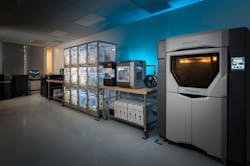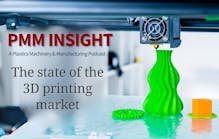3-D printing continues growth beyond prototyping, R&D
By Bruce Geiselman
Not many years ago, additive manufacturing (AM) was used primarily for research and prototyping, but a recent industry survey finds that more and more manufacturers are expanding their use of 3-D printing.
Jabil, a worldwide manufacturing services company that provides 3-D printing services, in March published a report based on a survey of 302 individuals responsible for decisions involving 3-D printing at manufacturers with annual revenues exceeding $500 million.
Nearly 50 percent of the respondents said they expect their use of 3-D printing for production parts to double over the next three to five years. Additionally, 90 percent use plastics and polymers for 3-D printing, up from 74 percent just two years ago.
Respondents anticipate a wide range of benefits from the increased use of 3-D printing to make production parts. They were especially optimistic about additive manufacturing’s ability to enable faster delivery of parts (66 percent) as well as the creation of personalized and customized goods (61 percent).
The report concluded that there are still challenges to overcome, particularly when it comes to scalability, cost and materials. However, “it does not appear that 3-D printing utilization is going to slow down any time soon,” according to "3D Printing Technology Trends: A Survey of Additive Manufacturing Decision-Makers." Sponsored by Jabil and based on data collected by Dimensional Research, the report is available at https://tinyurl.com/jabil3dreport.
Some key trends:
55 percent of respondents said they use at least a quarter of their 3-D printing capability to produce functional or end-use parts.
While prototyping has grown only slightly since 2019, all other uses of 3-D printing increased notably in the last two years.
Companies that manufacture production parts are likely to have 100 or more 3-D printers.
Expectations for “extreme growth” of 3-D printing continue into this year, with 87 percent predicting their use of the technology will at least double in the next five years.
Plastics are used more widely than metals in 3-D printing, but many companies use both, and the desire to use all types of materials is increasing.
The use of 3-D printing for R&D leaped by 20 percent, going from 53 percent to 73 percent of respondents between 2019 and 2021. The use of 3-D printing to make jigs, fixtures and tooling experienced a similar increase, going from 37 percent to 57 percent of respondents.
Bridge production, which involves moving from prototyping to initial production, increased by 17 percent over the same period, from 39 percent to 56 percent of respondents. The number of manufacturers using 3-D printers for production parts increased from 52 percent to 62 percent.
Despite continued growth in the sector, companies continued to run into issues with production, according to the authors. Among the key findings, 95 percent of those surveyed reported financial barriers to the adoption of 3-D printing.
The most common complaint was material issues, specifically the cost or availability of the plastic or metal needed for 3-D printing. Fifty-four percent of respondents cited this problem, compared with 56 percent in 2019.
Forty-three percent of respondents reported difficulty finding enough qualified personnel and experts to increase the use of 3-D printing in production. Meanwhile, 42 percent cited platform issues, such as the availability or cost of printers.
Ecosystem issues, related to connectivity to the supply chain, enterprise resource planning systems and manufacturing execution systems, were cited by 38 percent of respondents, an increase from 25 percent in 2019.
“This could be due — at least in part — to the fact that COVID-19 revealed vulnerabilities in many supply chains and created substantial obstacles for manufacturing,” the report says. “Companies across all industries were forced to evaluate the speed and agility of their operational processes as well as how smoothly everything works together.”
In spite of numerous challenges to wider adoption, respondents were unanimous in their belief that the technology will bring a wide range of benefits.
“They were especially optimistic about additive manufacturing’s ability to enable faster delivery of parts as well as the creation of personalized and customized goods,” the report said.
Beyond the numbers
Jabil has more than 100 sites in 30 countries, generating $27.3 billion in annual revenue, said Rush LaSelle, senior director and GM of additive manufacturing.
The company offers a range of manufacturing technologies, including injection molding, and it has offered 3-D printing services to some degree for about 20 years. About six to seven years ago, Jabil ramped up its 3-D printing capabilities, and today it offers R&D; prototyping; production of jigs, fixtures and tooling; bridge production; serial production; and part repair.
The growth of Jabil’s 3-D printing services stems from its longstanding relationship with HP and its Multi Jet Fusion technology, which reduced the costs of 3-D printing, increased throughput and reduced the time to bring parts to market, LaSelle said.
“We jumped on that [technology] in a multitude of ways,” LaSelle said. “We are a manufacturer of some of their printers.”
Jabil was such an early adopter that it has multiple HP MJF printers, starting with the second commercially produced machine.
“We actually brought in serial No. 2 of that platform,” LaSelle said.
Today, Jabil provides 3-D printing services to clients in the automotive, consumer electronics, health-care, aerospace and other industries.
It also has begun printing production parts for clients, but only in certain industries.
“We don’t do serial production across all of our sectors yet, just because the cost curves aren’t there,” LaSelle said. “We’re really focused on the high value — health care, aerospace and a little transportation.”
While many of Jabil’s manufacturing sites have the capability for R&D and prototype 3-D printing, the company has eight sites that concentrate on production parts — five sites print in plastic and three sites print metal parts, LaSelle said.
Jabil operates more than 100 printers around the world, he said.
The company’s serial production is focusing on high-value parts that can benefit from lightweighting, such as substituting plastics for metal, or printing a single part rather than assembling several individual parts. The automotive industry, with a move toward lighter electric vehicles, is another sector that is 3-D printing production parts, LaSelle said.
“We do both polymer and metals, and the reality is that we’re really seeking out high-value parts where you can drive better performance, and when I say that, I mean lighter weighting,” LaSelle said. “We talk a lot about BOM, or build-of-material consolidation, such as taking 50 parts and condensing them in 3-D design down to two.”
Production printed parts also tend to involve smaller lot sizes, because it makes more sense for manufacturers to invest in injection molding tooling once they start producing hundreds of thousands or millions of parts, LaSelle said.
While the results of this year’s "3-D Printing Technology Trends" report didn’t surprise LaSelle, he said he was encouraged by the number of respondents who plan to increase their volume of production parts.
“I wasn’t overly surprised as much as I was really genuinely pleased to see the uptick in numbers,” LaSelle said. “We’ve seen a number of drivers, including the supply-chain disruptions from COVID. Incidentally, we’re seeing it again because of the Suez Canal [blockage]. The supply chain is a big driver for the need for regionalized manufacturing, and AM is uniquely equipped to help solve some of those problems … More people are looking at additive manufacturing as a production tool for serial manufacturing than we’ve ever seen in the past.”
Customization
Customization is another area in which 3-D printing excels.
“The largest growth is in health care, and it’s really around customized implants — hips, knees, and things of that nature,” LaSelle said. “It’s not solely the device that goes in your body — the implant itself — but it’s all the instrumentation that surgeons really want customized either to themselves or to the actual procedure.”
Printing health-care implants and devices involves a lot of titanium, as well as high-temperature plastics like PEEK and PEKK. The materials are frequently used to print oral implants, dental prosthetics and cranial implants.
PEEK and PEKK are largely used for their mechanical performance and biocompatibility, but also because of their high processing temperatures, which permit them to be sterilized using various techniques such as autoclaving.
Other areas of customization include helmets and insoles.
“We’re seeing a lot more activity in two places on your body — one is your feet and the other one is your head,” LaSelle said. “We see applications around bicycle helmets, motorcycle helmets, sports helmets and things of that nature. The NFL has done a heck of a job publicizing the challenge of one-size-fits-all.”
Obstacles
Despite survey respondents expressing greater interest in adopting 3-D printing, a few obstacles remain.
“The materials are just prohibitively expensive, and that’s one of the things we are trying to address along with a host of others,” LaSelle said. “The cost of materials themselves to get them ready to go into a 3-D printer as compared to injection molding machines has been prohibitively expensive.”
A second obstacle is that 3-D printing technology is still inherently slow compared with other technologies.
“The throughput per square foot in our factory space still relegates it to the highest-value applications,” LaSelle said.
LaSelle is optimistic about the future of 3-D printing and expects it to continue growing in popularity, but he said it won’t completely replace injection molding.
“That’s just not our view,” he said. “We are a huge, huge user of injection molded components. We just think this is another arrow in the quiver.”
Bruce Geiselman, senior staff reporter
bgeiselman@plasticsmachinerymagazine.com
Contact:
Jabil Inc., St. Petersburg, Fla., 727-577-9749, www.jabil.com
Related stories
From prototypes to production, manufacturers harness evolving 3-D technology.
Printing's advantages shine in pandemic, says 3DChimera co-founder.
Rize executives say printing offers personalization at push of a button.
Stratasys to launch production-scale 3-D printers.
3YourMind sees a growing market for printing spare parts.
Jabil develops a new high-strength filament to meet customer demand.
Additive manufacturing grew in 2020 despite pandemic, says Wohlers Report.
Bruce Geiselman | Senior Staff Reporter
Senior Staff Reporter Bruce Geiselman covers extrusion, blow molding, additive manufacturing, automation and end markets including automotive and packaging. He also writes features, including In Other Words and Problem Solved, for Plastics Machinery & Manufacturing, Plastics Recycling and The Journal of Blow Molding. He has extensive experience in daily and magazine journalism.






